
Concept explainers
(a)
The mass M in terms of m, g , and
(a)
Answer to Problem 88AP
The mass M in terms of m, g , and
Explanation of Solution
The system is in equilibrium, so force on either sides of the pulley must be the same.
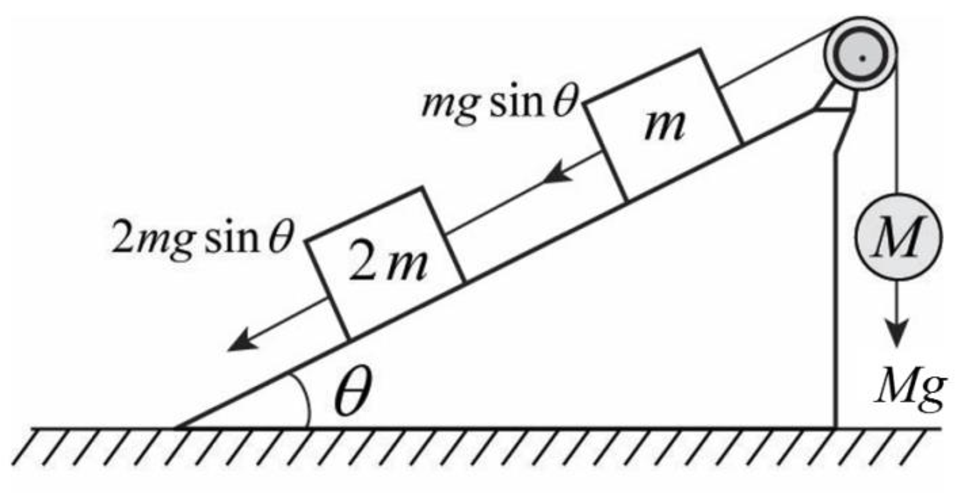
Write the expression for the equilibrium.
Here,
Conclusion:
Simplify the above equation.
Therefore, the mass M in terms of m, g, and
(b)
The tension
(b)
Answer to Problem 88AP
The tension
Explanation of Solution
Below figure shows the forces and tension acting on the string.
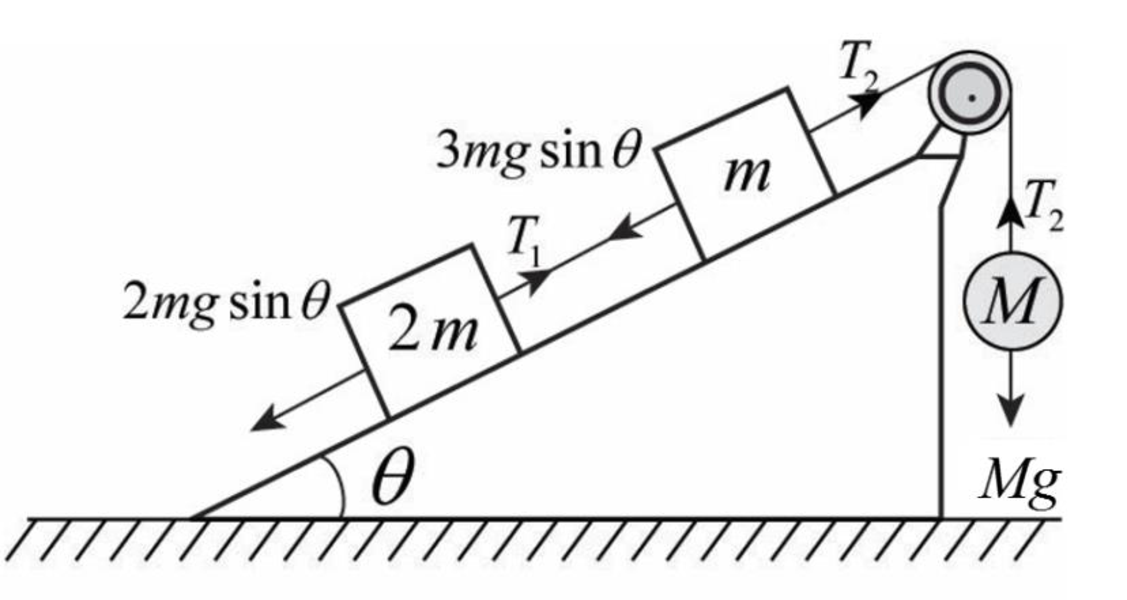
From the figure,
From the figure,
Conclusion:
Therefore, the tension
(c)
The acceleration of each object
(c)
Answer to Problem 88AP
The acceleration of each object is
Explanation of Solution
Below figure shows the forces and tension acting on the string.
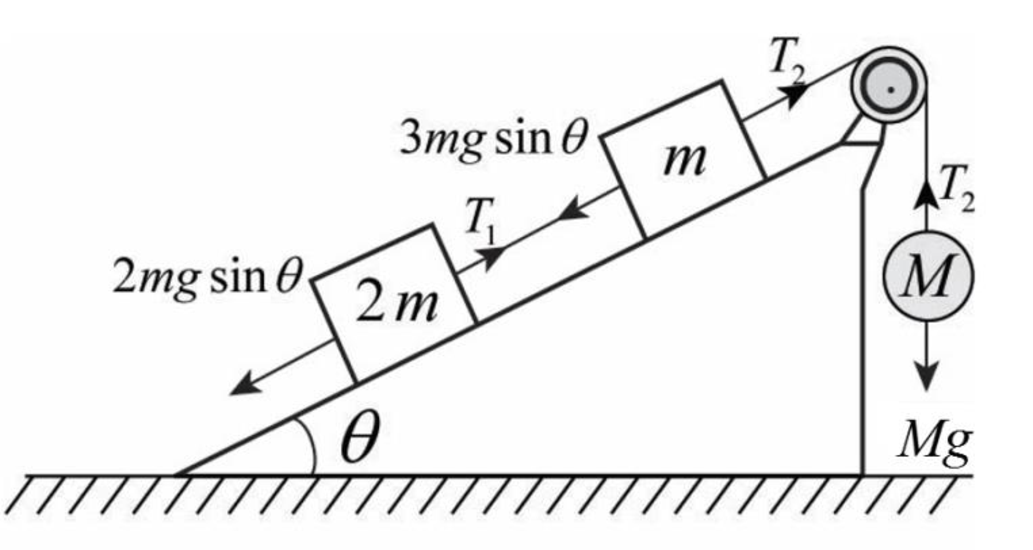
Use Newton’s second law to write the expression for tension
Use Newton’s second law to write the expression for tension
Substitute
Use Newton’s second law to write the expression for tension
Conclusion:
Substitute equation (I) and (II) in (III) and simplify.
All the objects are connected to a single string and hence they have same acceleration.
Therefore, the acceleration of each object is
(d)
The tension
(d)
Answer to Problem 88AP
The tension
Explanation of Solution
Rewrite (I).
Rewrite (II).
Conclusion:
Substitute
Substitute
Therefore, the tension
(e)
The maximum value of
(e)
Answer to Problem 88AP
The maximum value of
Explanation of Solution
Below figure shows the forces acting on the system (including frictional force).
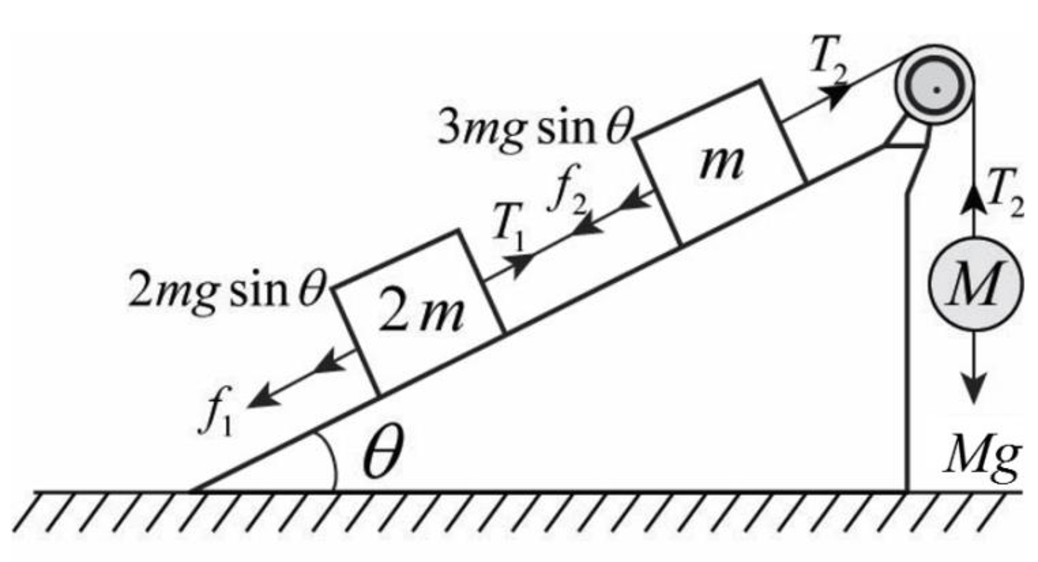
From the figure
Write the expression for friction force acting on
Here,
Write the expression for friction force acting on
Write the expression for tension
The system is in equilibrium,
Substitute 0 for
Similarly, Write the expression for tension
Substitute 0 for
Write the expression for
Substitute 0 for
Substitute
Conclusion:
Equate (V) and (VII).
Therefore, the maximum value of
(f)
The minimum value of
(f)
Answer to Problem 88AP
The minimum value of
Explanation of Solution
For minimum value of
Below figure shows the forces acting on the system (including frictional force).
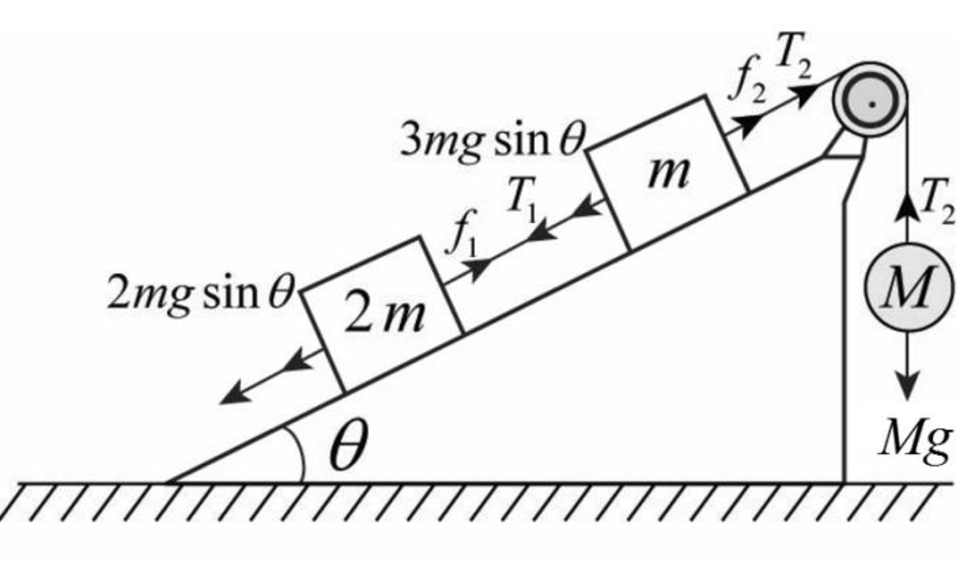
Therefore,
Conclusion:
Equate both the above expression for
Therefore, the minimum value of
(g)
Comparison the values of
(g)
Answer to Problem 88AP
Comparison the values of
Explanation of Solution
Compare (IX) and (VIII).
Conclusion:
Therefore, the Comparison of the values of
Want to see more full solutions like this?
Chapter 5 Solutions
Physics For Scientists And Engineers With Modern Physics, 9th Edition, The Ohio State University
- 3. If the force of gravity stopped acting on the planets in our solar system, what would happen? a) They would spiral slowly towards the sun. b) They would continue in straight lines tangent to their orbits. c) They would continue to orbit the sun. d) They would fly straight away from the sun. e) They would spiral slowly away from the sun. 4. 1 The free-body diagram of a wagon being pulled along a horizontal surface is best represented by A F N B C 0 Ꭰ FN E a) A b) B c) C app app The app 10 app d) e) ס ח D E 10 apparrow_forwardPls help ASAParrow_forwardPls help asaparrow_forward
- Pls help asaparrow_forwardThe acceleration of an object sliding along a frictionless ramp is inclined at an angle 0 is 9. a) g tano b) g cose c) g sino 10. d) g e) zero A 1.5 kg cart is pulled with a force of 7.3 N at an angle of 40° above the horizontal. If a kinetic friction force of 3.2 N acts against the motion, the cart's acceleration along the horizontal surface will be a) 5.0 m/s² b) 1.6 m/s² c) 2.4 m/s² 11. d) 1.0 m/s² e) 2.7 m/s² What is the net force acting on an object with a mass of 10 kg moving at a constant velocity of 10 m/s [North]? a) 100 N [North] b) 100 N [South] 10 N [North} d) 10 N [South] e) None of these.arrow_forwardModified True/False - indicate whether the sentence or statement is true or false. If the statement is false, correct the statement to make it true. 12. An object in uniform circular motion has a constant velocity while experiencing centripetal acceleration. 13. An object travelling in uniform circular motion experiences an outward centrifugal force that tends to pull the object out of the circular path. 14. An object with less inertia can resist changes in motion more than an object with more inertia. 15. For an object sliding on a horizontal surface with a horizontal applied force, the frictional force will always increase as the applied force increases.arrow_forward
 Principles of Physics: A Calculus-Based TextPhysicsISBN:9781133104261Author:Raymond A. Serway, John W. JewettPublisher:Cengage Learning
Principles of Physics: A Calculus-Based TextPhysicsISBN:9781133104261Author:Raymond A. Serway, John W. JewettPublisher:Cengage Learning Physics for Scientists and Engineers, Technology ...PhysicsISBN:9781305116399Author:Raymond A. Serway, John W. JewettPublisher:Cengage Learning
Physics for Scientists and Engineers, Technology ...PhysicsISBN:9781305116399Author:Raymond A. Serway, John W. JewettPublisher:Cengage Learning Physics for Scientists and Engineers: Foundations...PhysicsISBN:9781133939146Author:Katz, Debora M.Publisher:Cengage Learning
Physics for Scientists and Engineers: Foundations...PhysicsISBN:9781133939146Author:Katz, Debora M.Publisher:Cengage Learning Classical Dynamics of Particles and SystemsPhysicsISBN:9780534408961Author:Stephen T. Thornton, Jerry B. MarionPublisher:Cengage Learning
Classical Dynamics of Particles and SystemsPhysicsISBN:9780534408961Author:Stephen T. Thornton, Jerry B. MarionPublisher:Cengage Learning Physics for Scientists and Engineers with Modern ...PhysicsISBN:9781337553292Author:Raymond A. Serway, John W. JewettPublisher:Cengage Learning
Physics for Scientists and Engineers with Modern ...PhysicsISBN:9781337553292Author:Raymond A. Serway, John W. JewettPublisher:Cengage Learning Physics for Scientists and EngineersPhysicsISBN:9781337553278Author:Raymond A. Serway, John W. JewettPublisher:Cengage Learning
Physics for Scientists and EngineersPhysicsISBN:9781337553278Author:Raymond A. Serway, John W. JewettPublisher:Cengage Learning





